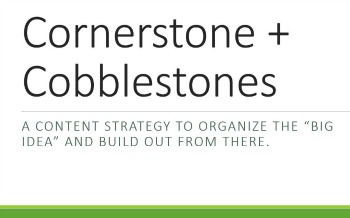We’ve talked before about invisible buyers, a term coined by my friend Tom Martin to describe the fact that people do a lot of online homework before they pick up a phone, email, or even send you a tweet. This means that if you don’t pique their interest you may never even get the chance to talk to a potential customer (or client, patient, member, and so forth).
You need to feed their need for information.
More and more companies understand this. But only a small percentage are strategically deploying content strategies to guide prospects from browsing to buying. Even more are struggling with the effectiveness of their content.
A recent report, The State of the Conversation, identifies four content approaches:
- company-centric
- product-centric
- problem-centric
- insights-centric
Let’s look at these.
There is good news about corporate messaging.

The good news is that there is less corporate messaging.
This means, at a minimum, organizations are waking up to the reality that people just don’t much care about corporate bios (isn’t that what LinkedIn is for?), who was promoted, or the size of your trade show booth. That’s about you, but largely will never resonate with me.
That’s not to say some “about you” content isn’t important. The key is to tell your story in a way that resonates with your audience.
The bad news: there’s still too much corporate on corporate sites.

According to the report, companies focus a lot of their efforts on product-centric messaging. This means that if you’re selling hammers, for example, you’re likely describing the wood, the metal, the sturdiness, and the price. If you’re selling a service, you’re talking about what the service does and how it’s delivered. While that’s all good, what’s in it for me?
The better news: problem-centric content is on the rise.

Organizations may still be focused on product-centric content, but they’re also turning their attention to problem solving. Going back to the hammer example, I want to know it’s well made — but I also want to know I can use it to hang a painting or pound in ill-fitting Ikea dowels. If I’m buying a service, I want to know both what it entails and how it’s going to help me.
As people do their homework about you, be the business that not just describes what you do but shows them how you can help.
There’s a huge content opportunity to stand out from the crowd.

The State of the Conversation concludes, in part:
“Many companies are seeing sub-par results with their marketing lead-to-sales pipeline conversions. Some of the biggest challenges appear to be related to messaging, and specifically, to the fact that companies aren’t creating enough insights-driven content to drive action… The relative lack of insights-driven content—based on identifying “unconsidered needs” and linking them to your unique strengths—could be holding companies back from creating meaningful differentiation.”
In other words, a lot of businesses are failing to connect what they do to the bigger picture. They’re still stuck in corporate speak.
They’re not being visionary.
Too many companies are focused on what’s right in front of them. If you can step back to look ahead (and use data to back up your point of view), you can spot or drive trends and even create market demand.
Feature photo by Patrick Denker (Flickr). Also via Flickr: “Good” by ClearlyAmbigous; “Bad” by NathanMac87; “Problem Solving” by U.S. Coast Guard Academy; and “Lotsa Luck” by ContentAction.



